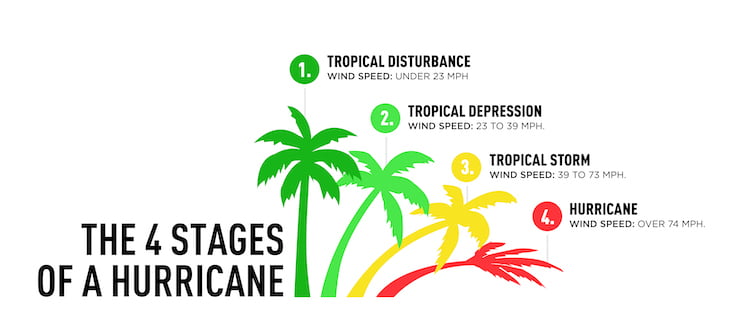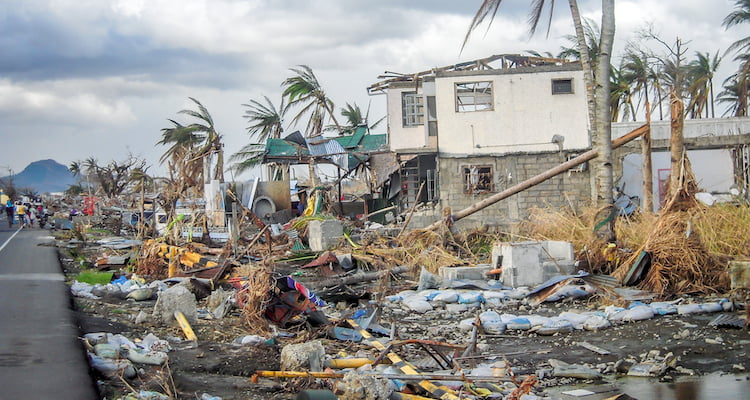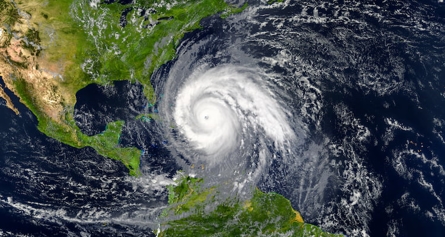
Hurricanes are some of the most dangerous storms you can encounter in the United States, with a recent CBO report estimating that the typical annual economic loss from these storms totals around $54 billion a year. These destructive storms are among the most unique weather patterns that those in the United States, especially in Texas and Florida, have to deal with.
For those who have lived through a hurricane, you might consider yourself an expert. You might know all about the dangerous aftermath that hurricanes cause and what supplies are needed in case there’s a warning or watch, but do you know how a hurricane begins? Knowing how a hurricane forms can help you better prepare for when it’s time to evacuate and seek shelter.
Hurricane Formation Steps
A hurricane is a type of tropical cyclone. All tropical cyclones, from depressions to hurricanes, begin the same way.
Tropical cyclones form in warm ocean water near the equator. The warm ocean water evaporates creating warm, moist air. The warm, moist air rises and condenses into water droplets. These water droplets create storm clouds. When these storm clouds combine with wind blowing across the Atlantic Ocean, the cluster of clouds are blown into a circular pattern around a center, forming a tropical cyclone.
Hurricanes, which are the most powerful tropical cyclones, have four stages:
1. Tropical Disturbance
A tropical disturbance is the first stage of hurricane development. It is characterized by a mass of storm clouds with only slight wind circulation and little potential for damage. A tropical disturbance is upgraded to a tropical depression when its maximum surface winds exceed 23 mph.
2. Tropical Depression
The second stage of a hurricane’s development is a tropical depression. In this stage, the storm expands and its wind speeds reach 23 to 39 mph.
3. Tropical Storm
A tropical storm is the third stage of hurricane development. Tropical storms have maximum sustained surface winds of 39 to 73 mph. It is in this stage that the storm becomes more organized and starts to form a circular shape. Once a storm becomes a tropical storm, it is given a name. Tropical storms can easily and quickly become hurricanes, so if a tropical storm is forecasted for your area, be ready to put your preparedness plan into action.
4. Hurricane
The fourth stage of development is an actual hurricane, which is when a storm is at its most powerful and most dangerous. There are some notable differences between a tropical storm and a hurricane, but ultimately the sustained wind speed dictates the term used. A hurricane’s maximum sustained surface winds are at or exceed 74 mph. The eye of the storm is easily identified in a hurricane.

Certain areas of the United States are prone to hurricanes. States like Florida, Texas, Louisiana, and the Carolinas are the most likely to be hit by hurricanes due to their location near the coast. Regardless of the hurricane category, they can cause extensive damage throughout an area.

What Damage Can Hurricanes Cause?
Hurricanes bring intense winds, waves and even tornadoes, but flooding causes the most damage to properties. Heavy rain from hurricanes not only affects areas it directly impacts, it can cause flooding in non-coastal areas as well, which means significant damage to your home if it’s in an area that is prone to flooding.
Due to the flooding, there may be significant water damage to your home, which can lead to foundation, walls, and other damage to areas of your property. Only a water damage restoration expert will be able to properly remove the water and ensure that your home is not at risk of long-term damages that could remain long after the water goes away, such as mold and lingering odors.
In the 2020 Atlantic hurricane season, more than 430 people died and the total damage incurred was almost $47 billion. Due to climate change, hurricane seasons have been predicted in the coming years to be even more dangerous, with more cities and properties at risk of damage.
Recover from Hurricane Damage to Your Property
Even for those who have experienced many storms, everyone should take approaching hurricanes seriously and create a plan that includes details about evacuation and supplies to stockpile. In addition, monitor local flood watches and warnings issued by the National Weather Service.
If you do experience home damage from a hurricane or other tropical storm, ServiceMaster Restore is ready to respond. We will work with you to restore your home quickly while ensuring that you have the support you need throughout the process. We have more than 850 locations across the United States that are locally owned and operated.
Our team is also backed by over 65 years of experience providing storm damage cleanup and restoration services to homeowners across the country. Our restoration experts will help you and your home get back to normal as quickly as possible.
Call 1-800-RESPOND to reach our disaster response center 24 hours a day, 7 days a week, 365 days a year.
